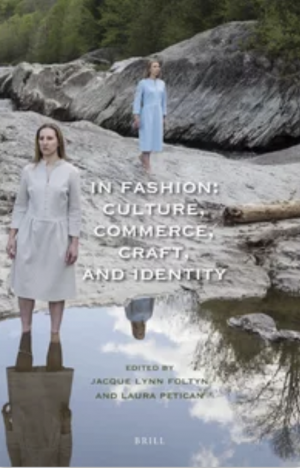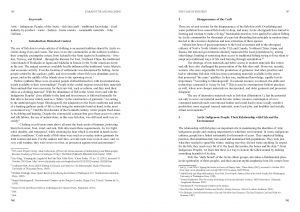Palomino, E., Karadottir, K. (2021) Fish skin, a historical material assimilated as a sustainable material for fashion. In: Fashion: Culture, Craft, and Identity. Brill.
The use of fish skin to create articles of clothing is an ancient tradition in Arctic
societies located along rivers and coasts, and there is evidence of fish skin leather
production in Scandinavia, Alaska, Hokkaido, Japan, Northeast China, and
Siberia. This chapter is a study of northern indigenous fish skin heritage and builds
connections among anthropology, ethnography, and material culture to address
current global issues of fashion sustainability. It critically examines the historical
application of the fish-skin craft and investigates the relationship of Arctic
indigenous people with fish and the environment, fish skin fashion in the Arctic,
the importance of women in fish skin art, the disappearance of the craft. Another
topic is how the use of fish skin by aboriginal Arctic people has recently been
assimilated as an innovative sustainable material for fashion because of its low
environmental impact. Fish skins are sourced from the food industry, using waste,
applying the principle of circular economy. The case study of the fashion designer
John Galliano’s use of fish leather for garments in his Autumn/Winter 2002
collection is presented, situating the use of fish leather within the context of the
luxury industry. The skins were sourced at Atlantic Leather, the world’s biggest fish
skin tannery, based in Iceland, and the authors describe the contemporary use of
fish skin in the fashion industry. The research proposes the sustainable development
of fish skin as an innovative raw material for the fashion industry in order to
encourage more sustainable fashion practices. A qualitative methodology has been
employed for its relevance in studying evolving processes. An arts-based inquiry
was chosen to create new knowledge conceived by those who actively participate in
its making. Methodologically, the approach was practice-led. Emphasis was placed
on ‘hands on interaction’ with the fish skin and processes.
https://doi.org/10.1163/9789004446595_011
- Palomino, E., Pardue, J., Donkan, A. (2023) Fish skin Peoples of the Bering Strait: Encounters in Hokkaido, Japan. Smithsonian Institution National Museum of natural History. Arctic Studies Center Newsletter. May 2023. N.30. pp.74-75
- Palomino, E. (2022) Indigenous Arctic Fish Skin Heritage: Sustainability, Craft and Material Innovation. PhD Thesis. University of the Arts, London.
- Palomino, E., Cloud, J. (2022) The Arctic as viewed from Florence. Arctic Studies Center Newsletter, Smithsonian National Museum of Natural History.
- Palomino, E. (2021) Fish Skin Coat from the Amur River. TEXT for the Study of the History Art Design of Textiles. V. 48: 2021. The Textiles Society, Pat Frost (ed)
- Trachter, F., Palomino, E., Defeo, G. (2021) Patagonian fish skin tanning processes. XXXVI IULTCS Congress Greening the Leather Value Chain
- Palomino, E., Pardue, J. (2021) Alutiiq Fish Skin Traditions: Connecting Communities in the COVID-19 Era. MDPI Heritage, 4, x. Academic Editor(s): Claire Smith.
- Palomino, E., Pardue, J., (2021) A virtual Alutiiq Fish Skin workshop during Covid-19 times. Smithsonian Institution National Museum of natural History. Arctic Studies Center Newsletter. May 2021. N.30.pp-16-17
- Palomino, E., Freilich, O., Raine, I. (2021) 'A virtual Ainu fish skin workshop during Covid 19'. Global Fashion conference. Academy of Fine Arts of Warsaw. ISBN: 978-989-54263-2-4
- Palomino, E., Karadottir, K. (2021) Fish skin, a historical material assimilated as a sustainable material for fashion. In: Fashion: Culture, Craft, and Identity. Brill.
- Palomino, E., Boon, J. (2020) Preservation of Hezhen Fish Leather tradition through Fashion Education. Textiles, Identity and Innovation. Taylor & Francis.
- Palomino, E. (2020) Fashion workshop in Anchorage. Smithsonian Institution National Museum of natural History. Arctic Studies Center Newsletter. May 2020. N.27.pp. 57-58
- Palomino, E., Karadottir, K., Phirry, E. (2020) Indigenous Fish Skin Craft Revived Through Contemporary Fashion. International Foundation of Fashion Technology Institutes Journal. ISSN: 2694-5193
- Palomino, E. Defeo, G. (2019) Material Design Research - Fish skin, a new environmental -friendly material for fashion. Design Research for Change. Design Museum, London ISBN 978-1-86220-369-3
- Palomino, E. Rahme, L. Karadottir, K. (2019) Indigenous Arctic Fish skin clothing traditions: Cultural and ecological impacts on Fashion HE. CUMULUS Conference Rovaniemi. ISBN 978-952-337-158-3.
- Palomino, E. (2019) SDG 14 Life Below Water Introducing Fish Skin as a Sustainable Raw Material for Fashion. In: Franco I., Chatterji T., Derbyshire E., Tracey J. (eds) Actioning the Global Goals for Local Impact. Science for Sustainable Societies. S







